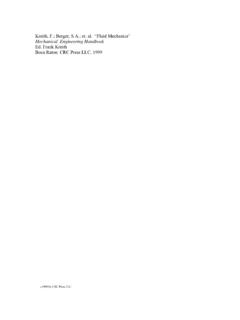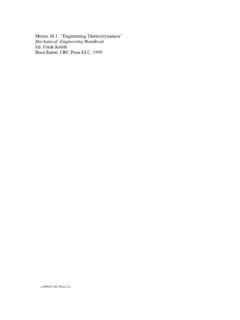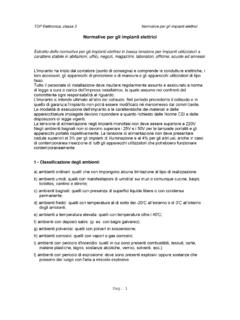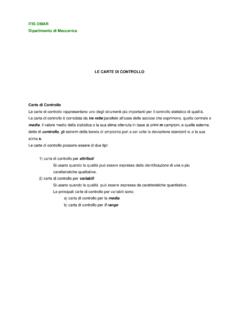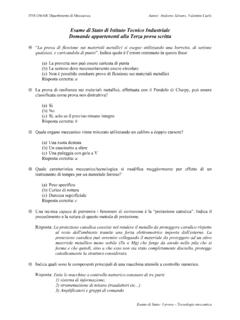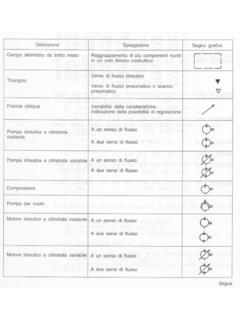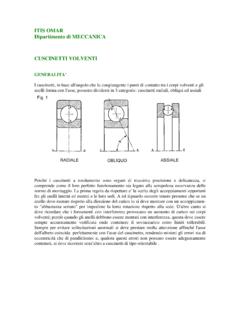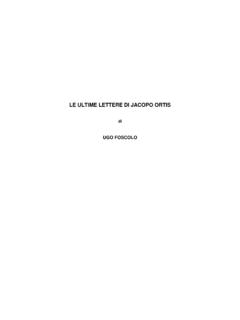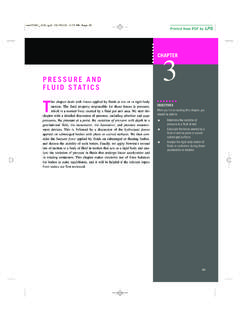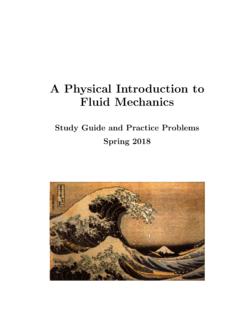Transcription of Kreith F.; Berger, S.A.; et. al. Fluid Mechanics ...
1 Kreith , F.; Berger, ; et. al. Fluid Mechanics mechanical engineering HandbookEd. Frank KreithBoca Raton: CRC Press LLC, 1999c 1999byCRCP ressLLC 3 -1 1999 by CRC Press LLC Fluid Mechanics * Equilibrium of a Fluid Element Hydrostatic Pressure Manometry Hydrostatic Forces on Submerged Objects Hydrostatic Forces in Layered Fluids Buoyancy Stability of Submerged and Floating Bodies Pressure Variation in Rigid-Body Motion of a Fluid of Motion and Potential Integral Relations for a Control Volume Reynolds Transport Theorem Conservation of Mass Conservation of Momentum Conservation of Energy Differential Relations for Fluid Motion Mass Conservation Continuity Equation Momentum Conservation Analysis of Rate of Deformation Relationship between Forces and Rate of Deformation The Navier Stokes
2 Equations Energy Conservation The mechanical and Thermal Energy Equations Boundary Conditions Vorticity in Incompressible Flow Stream Function Inviscid Irrotational Flow: Potential Flow : Dimensional Analysis and Data Dimensional Analysis Correlation of Experimental Data and Theoretical Values of Pipe Basic Computations Pipe Design Valve Selection Pump Selection Other Considerations Channel Definition Uniform Flow Critical Flow Hydraulic Jump Weirs Gradually Varied Flow Incompressible Introduction and Scope Boundary Layers Drag Lift Boundary Layer Control Computation vs. Experiment Introduction One-Dimensional Flow Normal Shock Wave One-Dimensional Flow with Heat Addition Quasi-One-Dimensional Flow Two-Dimensional Supersonic Flow Introduction Fundamentals Gas Liquid Two-Phase Flow Gas Solid, Liquid Solid Two-Phase Flows * Nomenclature for Section 3 appears at end of chapter.
3 Frank Kreith University of Colorado Stanley A. Berger University of California, Berkeley Stuart W. Churchill University of Pennsylvania J. Paul Tullis Utah State University Frank M. White University of Rhode Island Alan T. McDonald Purdue University Ajay Kumar NASA Langley Research Center John C. Chen Lehigh University Thomas F. I rvine, Jr. State University of New York, Stony Brook Massimo Capobianchi State University of New York, Stony Brook Francis E. Kennedy Dartmouth College E. Richard Booser Consultant, Scotia, NY Donald F. Wilcock Tribolock, Inc. Robert F. Boehm University of Nevada-Las Vegas Rolf D. Reitz University of Wisconsin Sherif A. Sherif University of Florida Bharat Bhushan The Ohio State University 3 -2 Section 3 1999 by CRC Press LLC Introduction Classification of Non-Newtonian Fluids Apparent Viscosity Constitutive Equations Rheological Property Measurements Fully Developed Laminar Pressure Drops for Time-Independent Non-Newtonian Fluids Fully Developed Turbulent Flow Pressure Drops Viscoelastic Fluids , Lubrication.
4 And Bearing Introduction Sliding Friction and Its Consequences Lubricant Properties Fluid Film Bearings Dry and Semilubricated Bearings Rolling Element Bearings Lubricant Supply Methods and Introduction Pumps Fans Atomization and Spray Characterization Atomizer Design Considerations Atomizer Types Direct Methods Restriction Flow Meters for Flow in Ducts Linear Flow Meters Traversing Methods Viscosity Measurements Introduction Experimental Techniques Surface Roughness, Adhesion, and Friction Scratching, Wear, and Indentation Boundary Lubrication Fluid Statics Stanley A. Berger Equilibrium of a Fluid Element If the sum of the external forces acting on a Fluid element is zero, the Fluid will be either at rest ormoving as a solid body in either case, we say the Fluid element is in equilibrium.
5 In this section weconsider fluids in such an equilibrium state. For fluids in equilibrium the only internal stresses actingwill be normal forces, since the shear stresses depend on velocity gradients, and all such gradients, bythe definition of equilibrium, are zero. If one then carries out a balance between the normal surfacestresses and the body forces, assumed proportional to volume or mass, such as gravity, acting on anelementary prismatic Fluid volume, the resulting equilibrium equations, after shrinking the volume tozero, show that the normal stresses at a point are the same in all directions, and since they are knownto be negative, this common value is denoted by p , p being the pressure.
6 Hydrostatic Pressure If we carry out an equilibrium of forces on an elementary volume element dxdydz , the forces beingpressures acting on the faces of the element and gravity acting in the z direction, we obtain( )The first two of these imply that the pressure is the same in all directions at the same vertical height ina gravitational field. The third, where g is the specific weight, shows that the pressure increases withdepth in a gravitational field, the variation depending on r ( z ). For homogeneous fluids, for which r =constant, this last equation can be integrated immediately, yielding rgpxpypzg===-=-0, and Fluid Mechanics 3 -3 1999 by CRC Press LLC ( )or( )where h denotes the elevation.
7 These are the equations for the hydrostatic pressure applied to problems where a liquid, such as the ocean, lies below the atmosphere, with aconstant pressure p atm , h is usually measured from the ocean/atmosphere interface and p at any distance h below this interface differs from p atm by an amount( )Pressures may be given either as absolute pressure, pressure measured relative to absolute vacuum,or gauge pressure, pressure measured relative to atmospheric pressure. Manometry The hydrostatic pressure variation may be employed to measure pressure differences in terms of heightsof liquid columns such devices are called manometers and are commonly used in wind tunnels anda host of other applications and devices.
8 Consider, for example the U-tube manometer shown in filled with liquid of specific weight g , the left leg open to the atmosphere and the right to the regionwhose pressure p is to be determined. In terms of the quantities shown in the figure, in the left leg( )and in the right leg( )the difference being( ) FIGURE U-tube gzz ghh21 21 21-=- -()=- -()rrpghpgh2211+=+=rrconstantpp gh-=atmrpghp02-=ratmpghp01-=rpp ghh gd d-=--()=- =-atmrrg12 3 -4 Section 3 1999 by CRC Press LLC and determining p in terms of the height difference d = h 1 h 2 between the levels of the Fluid in thetwo legs of the manometer. Hydrostatic Forces on Submerged Objects We now consider the force acting on a submerged object due to the hydrostatic pressure.
9 This is given by( )where h is the variable vertical depth of the element dA and p 0 is the pressure at the surface. In turn weconsider plane and nonplanar surfaces. Forces on Plane Surfaces Consider the planar surface A at an angle q to a free surface shown in Figure The force on oneside of the planar surface, from Equation ( ), is( )but h = y sin q , so( )where the subscript c indicates the distance measured to the centroid of the area A . Thus, the total force(on one side) is( )Thus, the magnitude of the force is independent of the angle q , and is equal to the pressure at thecentroid, g h c + p 0 , times the area. If we use gauge pressure, the term p 0 A in Equation ( ) can p is not evenly distributed over A , but varies with depth, F does not act through the point action of F , called the center of pressure , can be determined by considering moments in The moment of the hydrostatic force acting on the elementary area dA about the axis perpendicularto the page passing through the point 0 on the free surface is( )so if y cp denotes the distance to the center of pressure,( )where I x is the moment of inertia of the plane area with respect to the axis formed by the intersectionof the plane containing the planar surface and the free surface (say 0 x ).
10 Dividing by F = g h c A =gycsinqA givesF dA n dA dA== =+ p p dA gh pr0Fn n=+ rghdApAA0hdA ydAyA hAAAcc ===sin sinqqFAA=+ghpc 0ydFyy dA y dA=()=gqgqsin sin2yF ydA Ixcp== gq gqsin sin2 Fluid Mechanics 3-5 1999 by CRC Press LLC( )By using the parallel axis theorem Ix = Ixc + where Ixc is the moment of inertia with respect to anaxis parallel to 0x passing through the centroid, Equation ( ) becomes( )which shows that, in general, the center of pressure lies below the , we find xcp by taking moments about the y axis, specifically( )or( )where Ixy is the product of inertia with respect to the x and y axes.
